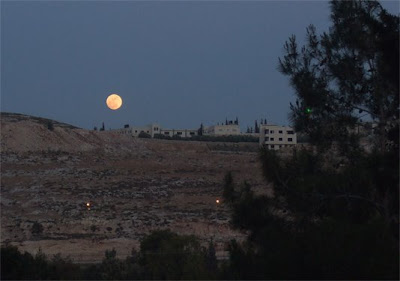 Ragweed/ragwort is in season now, growing like mad wherever it can. Senecio or similar (This is NOT the same plant called ragweed in the Americas, which is genus Ambrosia, though Senecio has been introduced in the east U.S and become a pest )
Ragweed/ragwort is in season now, growing like mad wherever it can. Senecio or similar (This is NOT the same plant called ragweed in the Americas, which is genus Ambrosia, though Senecio has been introduced in the east U.S and become a pest )
Today's range: 18-just over 29 degrees C. Temp at about 6.30 p.m. 25.3 degrees, humidity 45%, wind westerly 14.8 degrees. Wind had shifted easterly at about 7 a.m. and back to the west at about 1.30 p.m. which reminded me of the wind shift in the movie 'Massada' which blew the fire at the Roman tower. We see lately that such shifts to the east and back happen regularly here, particularly through part of the morning and early afternoon. (Massada is not far south of here by car, we should take a trip down there to find brown necked ravens and other goodies for this blog:)
As for fires here, no new fires broke out today as far we we know. I checked out the ground again at the west end of gazelle field. Several inches below the surface in an ash sump (seems a tree stump was there) the temps were still hot- this was now 48 hours after the fire went out on the surface. Checking out the pistaccio orchard there is some damage to lower leaves on some trees but most leaves and trees escaped harm. Husband noticed a couple of pines with branches bent almost down to the ground and much of those burned. Seems to me heat generated in the ground could ignite the inflammable resins in the cones and other parts of the tree. Tomorrow we need to check the heat of the ground there.
What could actually cause ignition? The heat alone or theoretically sun focussed through beads of resin exuded from the trees would act as a magnifying glass. Just an idea. That would work for the pines but the pistaccios?
(Husband and son went to the cotel/wailing wall in the morning where they saw lots of swifts. No Tristram's grackles today. (In the past I've seen kestrels and up to 4 Tristram's around the Al Aqsa mosque. They also saw some kind of Buteo near my sons' school, at about the highest point of the neighbourhood and not far from where we saw the long legged buzzards the other day. They also saw quite a few agama lizards today, not surprising noting the temperatures)
As for birds, swifts heard about sunset. Hoopoe seen briefly near the ruins at centre of east valley. (The Hoopoe has just been voted the national bird. I'd have preferred something more local and endemic such as the sunbird, Tristram's grackle or our yellow vented white spectacled bulbul but this is one of the few places in its range where it's resident all year so there's some basis. ) A brief raptor call there again but no views so hard to know what it was, if sparrowhawk or something else.
A pair of stone curlew at the east end of the orchard/west end of east field again, good sightings. I'm sure their chicks must have been nearby but no luck spotting them. Lots of long grass for them to hide in on the field side. Usual greenfinches, Syrian woodpeckers, collared doves, turtle doves around the cistern area. Eurasian jays visiting for a drink and generally foraging, and plenty hooded crows about the forest as usual. Blackbirds, brief great tit call in the orchard area. Bee-eaters quite high overhead grabbing flying insects. Ring necked parakeet heard in the trees along the lower path. We didn't find that Alcea like plant again, perhaps the gazelle had eaten it which was a bit frustrating because I was rethinking my ID on that. There's a local cucumber relative with similar leaves and I wanted to see it develop, not that I'd begrudge the gazelle such tasty leaves! Pine branch burned where the branch touches the ground. Look at that, hadn't noticed the bottle before! That could have focussed the rays of the sun. We also need to check for ground heat in that bare patch.
Pine branch burned where the branch touches the ground. Look at that, hadn't noticed the bottle before! That could have focussed the rays of the sun. We also need to check for ground heat in that bare patch.
checking next day: husband does not believe line-up could have caused ignition from that bottle. Ground not right kind for heat build up there. Burnt sap on surrounding rocks. Must have been some other means of ignition of pine sap. Sunlight through bead of sap?




























